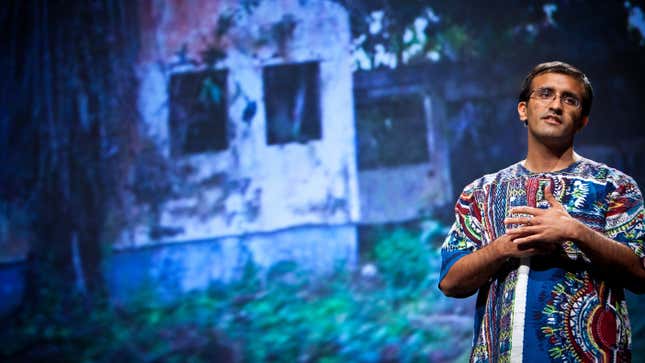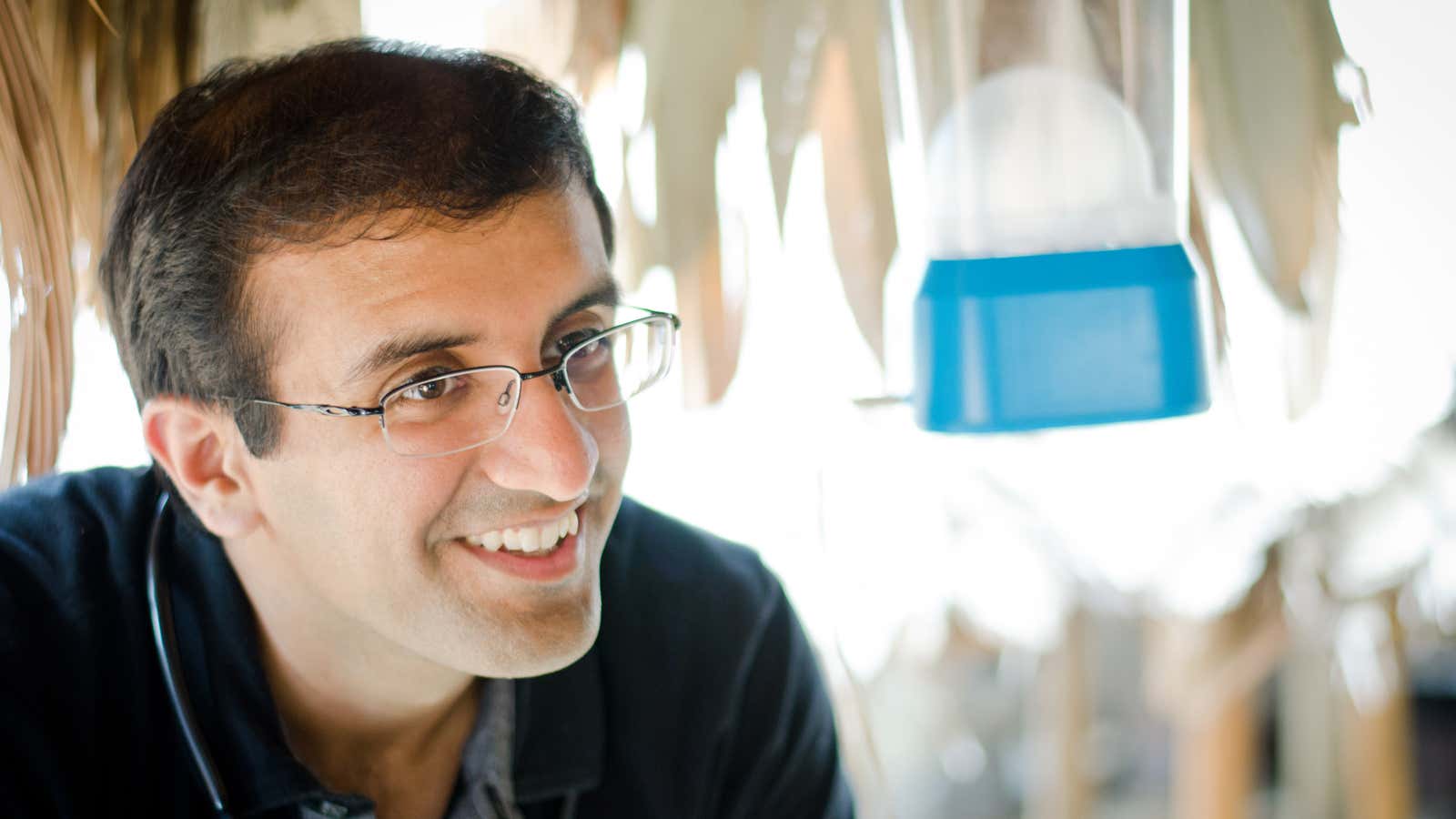It’s not often you’re handed $1 million and told to do whatever you’d like with it. That’s what’s just happened, though, to Raj Panjabi, a physician at the Brigham and Women’s Hospital in Boston who last week was awarded the 2017 TED Prize.
In 2007, Panjabi co-founded what would later become Last Mile Health with a group of Liberian civil war survivors and American health workers. The team’s mission is to recruit, train, and provide resources to health-care workers in far-flung communities in Libera.
“Panjabi and his team of community health workers have proven it possible to deliver world-class care in some of the most remote areas of the planet,” says Anna Verghese, director of the TED Prize.
The conversation below has been slightly edited for length and clarity.
Quartz: Have we done enough in the aftermath of the Ebola epidemic to prepare for the next one?
Panjabi: Where we have blind spots, such as in rural areas, these diseases tend to leap from animals to humans. These are the areas that become hot spots for outbreaks.
We know that the Ebola outbreak began with Emile, a two-year-old boy in southern Guinea. The disease spread undiagnosed between December 2013 and March 2014 through dozens of villages and then eventually into many countries causing 11,000 deaths and 28,000 infected. We also know that nearly 70% of all new diseases are zoonotic diseases, which means they originate in an animal species. Zika, HIV, and Ebola are prime examples.
Until we can make sure that those blind spots where rural people live can get health care, I don’t think we’ve done enough.
What do we need to do to reach these blind spots?
Investing in the people in remote rural areas might have a lot to do with enabling us to be safer in the future. It was clear during the Ebola crisis that local community health workers were really critical in responding to the disease.
In remote parts of Liberia, we’ve had cases where a disease has claimed one person, and then because the area is so cutoff—no roads, electricity, or even cellphones—the disease spread and killed all the people who attended her funeral. What we’ve been trying to do is work on a vision where there’s a health worker for everyone, everywhere, everyday.
The Liberian government has put forward the National Community Health Assistant program. It is an effort to train, equip, and employ over 4,000 community-health workers for the 1.2 million people who live in remote communities across Liberia. This group will provide surveillance, to help stop a local outbreak from becoming the next global pandemic; save lives, to provide essential services for mothers and children; and create jobs in areas we know where there are very few jobs available.
As you’ve noted, rural sub-Saharan Africa needs 1 million community health workers. How are you going to scale this effort?
We must reframe the money spent in these communities. We must not see it as cost but as investment. We put out a report with the United Nations and World Bank (pdf), where we found that if you invest $1 in trained and equipped community health workers then you get $10 in economic return. This comes from longer and healthier productive lives, from jobs created, and from preventing epidemics like Ebola.
We are also working with a group of organizations that supports community health workers in countries like Mali, some in East Africa, and some in India. They need to be able to employ community health workers and not, as is normal, get them to do the work on voluntary basis. One of the things we will be doing with the TED Prize team and the money we get is to launch a project to help us scale.
What about the top-down approach? We’ve seen from both Ebola and now Zika that the World Health Organization isn’t set up to deal with global pandemics.
Our experience with the Liberian government is a good one to see top-down approaches working. Ministries of finance, labor, health, and education are all critical to the program’s success. This kind of thing needs to happen in other countries at a national level.

At the global level, one of the initiatives that has come up is the Pandemic Financing Facility from the World Bank and there’s the US-led Global Health Security Agenda. These are both important on the emergency front.
But I don’t think we can separate emergency response systems from everyday response systems. What we’ve learned from Ebola is that what we need in an emergency is an everyday system that can adapt and respond.
We received Ebola funding to help some 240 remote communities in Liberia. We initially trained them to provide Ebola-related skills, but after the epidemic subsided we’ve repurposed those workers to provide help with malaria, pneumonia, diarrhea, and pregnancy. Several weeks after the Ebola epidemic ended, there was a pertussis outbreak. It has a much lower mortality rate, but it’s also a vaccine-preventable disease. These groups picked up the outbreak within days, not months, and response was mobilized within days.
But will these community health workers be able to deal with a completely new disease which may be capable of becoming the next pandemic?
It’s possible. To detect the difference between someone who is sick and someone who isn’t is a skill. With proper training, health workers can know when to refer to a higher authority.
In Nigeria, they didn’t know that Ebola was laying on its shores, when the gentleman with the disease traveled to Lagos. But because they had invested in polio workers, in a very short time they were able to conduct thousands of home visits after the first few cases were caught. And those cases were caught in days—not months, like in Guinea. That kind of investment pays off.
To a large extent, changes to the health-care system in Liberia are happening because of the Ebola outbreak. Can other countries actually act without such a shock?
I fled the war in Liberia as a nine-year-old, and came back as medical student as a 24-year-old. We were left with 51 doctors to serve 4 million people. Many pledges were made, but health-care spending—despite Ebola—is nowhere near what it should be.
So, yes, we are much more likely to respond when we feel the tension, the pressure, the insecurity. The urgency becomes critical.
And, yet, we have so many immature deaths happening around the world that it should be enough reason for panic. I feel that we are not doing a good enough job in communicating to people about how our everyday crises add up.
Where we’ve found success is when decision makers are able to spend time with the communities that suffer. And we’ve also seen success in bundling of health services with other priorities. In Liberia, it was clear that rural communities needed more jobs. The unemployment rates there are above 85%. The program we’re putting in place solves two problems: it provides health care and creates jobs. So in places where we can align multiple interests, we are likely to see better results.
Here’s my favorite annoying question: Why in 2016 do we have to worry about not having a simple and straightforward strategy to preventing a global pandemic?
The headlines look bad at any given point, but the trend lines in global health are actually quite positive. We’ve cut child mortality in half between 1990 and 2015. We weren’t able to do that in decades prior.
Your question is an earnest one: how do we accelerate that progress and make sure it reaches everyone?
Our market-based society has a triple bias when it comes to rural, remote areas. The public sector doesn’t prioritize them because there’s not enough density of votes. The private sector doesn’t prioritize them because they don’t see market potential. Even the non-profit sector—which is supposed to step in when the public and private sectors fail—doesn’t prioritize these regions because they do not allow us to minimize our resource-spending per person. Those are brutal layers of economics.
We have to reshape the policies and metrics for the way we reach remote, rural areas. If we can do that, then we can take some of these trends in global health and push modern medicine to everyone.
